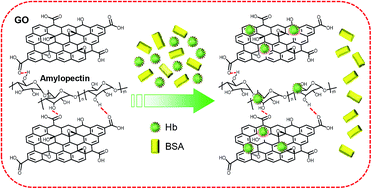A three-dimensional amylopectin-reduced graphene oxide framework for efficient adsorption and removal of hemoglobin
Abstract
A three-dimensional graphene oxide framework is prepared via a simple and cost-effective one-pot approach through the hydrogen-bonding interaction between amylopectin and graphene oxide in the presence of hydrazine hydrate acting as a reducing reagent. The framework is shortly termed as AP-rGO and it is characterized by Fourier transform infrared spectroscopy (FT-IR), scanning electron microscopy (SEM), surface charge analysis and thermogravimetric analysis (TGA). The obtained AP-rGO framework exhibits excellent adsorption performance toward hemoglobin in the presence of other protein species. It provides a maximum adsorption capacity of 1010 mg g−1. In a neutral medium (at pH 7), 70 mg L−1 of Hb in 1.0 mL of aqueous solution could be effectively adsorbed by 1.0 mg of the AP-rGO framework, giving rise to an adsorption efficiency of 92.7%. The practical application of the AP-rGO framework is demonstrated by the removal of a highly abundant protein, i.e., hemoglobin, from complex biological sample matrices, e.g., human whole blood. The removal efficiency is well confirmed by sodium dodecyl sulfate polyacrylamide gel electrophoresis (SDS-PAGE) assay.

- This article is part of the themed collection: 2015 Journal of Materials Chemistry B Hot Papers

 Please wait while we load your content...
Please wait while we load your content...